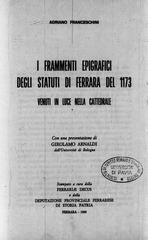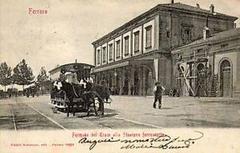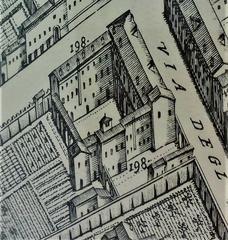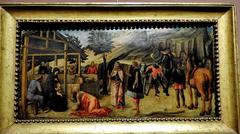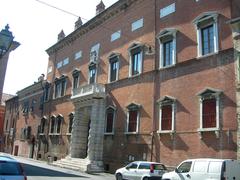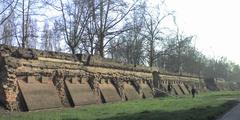
Studiolo di Belfiore: Visiting Hours, Tickets, and Ferrara Historical Sites Guide
Date: 04/07/2025
Introduction
The Studiolo di Belfiore stands as a testament to the cultural, artistic, and intellectual vibrancy of Renaissance Ferrara. Originally commissioned in the 15th century by Leonello d’Este, Duke of Ferrara, this intimate space was part of the Delizia di Belfiore, a pleasure villa designed for contemplation, artistic celebration, and scholarly pursuits. Although the original studiolo was destroyed, its legacy endures through a celebrated cycle of Muse paintings now dispersed across European museums, with key works displayed in Ferrara’s Pinacoteca Nazionale and the Palazzo dei Diamanti (Antica Ferrara; Wikipedia; Pinacoteca Nazionale di Ferrara).
This guide explores the Studiolo’s history, artistic significance, and practical information for visitors—including hours, ticketing, accessibility, and suggestions for exploring Ferrara’s other Renaissance treasures.
Origins and Construction
The Delizia di Belfiore, commissioned by Alberto V d’Este in the late 14th century, embodied the Este family’s embrace of the arts and leisure. Under Leonello d’Este’s patronage in 1447, the studiolo became a locus for humanist ideals and artistic innovation, intended as a retreat dedicated to the nine Muses. The architectural project was overseen by Bartolino da Novara, and the studiolo’s decorative program was conceived by Guarino Veronese, Leonello’s humanist tutor (Antica Ferrara; Wikipedia).
Artistic Features and Iconography
The Studiolo di Belfiore’s defining feature was its cycle of paintings depicting the nine Muses, each representing a distinct art or science. Artists such as Angelo Maccagnino, Michele Pannonio, and Cosmè Tura executed these panels, which were guided by a sophisticated iconographic program linking each Muse to specific human activities—often with a focus on agriculture and governance (Antica Ferrara; FrameLAB).
One of the Studiolo’s notable artistic innovations was the pioneering use of oil painting techniques, particularly in Cosmè Tura’s panel of Calliope, which is recognized as one of the earliest Italian oil paintings (National Gallery). The Muses are depicted with carefully chosen attributes, such as Calliope’s cherry branch symbolizing justice, and Terpsichore’s velvet dress referencing fertility and land reclamation efforts (Google Arts & Culture).
The Studiolo’s Role in Court Life
Far from being a simple private study, the Studiolo di Belfiore functioned as a venue for diplomatic and cultural gatherings. Leonello d’Este received scholars, poets, and ambassadors within its walls, establishing Ferrara as one of the leading centers of Renaissance humanism and courtly culture (Diario dell’Arte). The contents of the studiolo—paintings, scientific instruments, and rare books—were carefully curated to reflect the intellectual aspirations of the Este court.
Decline and Dispersal
After Borso d’Este’s death, the studiolo and its palace fell into neglect. The surrounding park was repurposed, and the Studiolo itself lost its original function. In 1483, Venetian troops besieged Ferrara and destroyed the Delizia di Belfiore, and a subsequent fire in 1683 erased what remained. Today, only the Muse panels survive, scattered across museums in Ferrara, London, Berlin, and Budapest (Antica Ferrara; Wikipedia).
Legacy and Surviving Artworks
Six of the nine original Muse panels are extant and displayed in leading institutions, such as the Pinacoteca Nazionale di Ferrara, Palazzo dei Diamanti, the National Gallery in London (National Gallery), and museums in Berlin and Budapest. The Studiolo di Belfiore remains influential as the first princely studiolo in Italy, shaping later Renaissance studioli in Urbino and Florence (FrameLAB).
Visiting the Studiolo di Belfiore: Hours, Tickets, and Tips
Where to See the Muse Panels
The Muse paintings are housed primarily at the Pinacoteca Nazionale di Ferrara inside the Palazzo dei Diamanti. The Palazzo is centrally located in Ferrara and easily accessible by public transport, bicycle, or on foot.
Opening Hours
- Pinacoteca Nazionale di Ferrara:
Tuesday to Sunday: 10:00 AM – 6:00 PM
Closed on Mondays
Check official museum websites for seasonal variations and exhibition schedules.
Tickets
- Adults: Approx. €8
- Reduced rates for students, seniors, and groups
- Combined tickets available (e.g., with the MyFE Card)
Advance online booking is recommended, especially during special exhibitions or peak travel periods.
Accessibility
Both the Palazzo dei Diamanti and Pinacoteca Nazionale are wheelchair accessible, with ramps, elevators, and accessible restrooms. Audio guides and guided tours are available in multiple languages. For more information or special requirements, contact the museum in advance.
Visitor Experience
- The Muse panels are displayed with detailed interpretive materials in Italian and English.
- Photography is generally permitted (no flash); please confirm on-site.
- Guided tours and family-friendly educational activities are available.
- Amenities include a bookshop, café, and accessible facilities.
The Studiolo di Belfiore Archaeological Site
The original site of the Delizia di Belfiore is located on Via Leopardi, Ferrara. While the studiolo structure no longer exists, archaeological excavations are periodically open to the public during special events or guided tours (Comune di Ferrara). Guided tour dates are limited and require advance reservation (email: [email protected]). These tours are generally free but may have limited accessibility due to ongoing excavations and uneven terrain.
Nearby Ferrara Historical Sites
Enhance your visit by exploring Ferrara’s other Renaissance landmarks:
- Castello Estense: The Este family’s fortress, open for tours and panoramic views.
- Ferrara Cathedral: A Romanesque-Gothic architectural marvel.
- Palazzo Schifanoia: Renowned for Renaissance frescoes.
- Palazzina Marfisa d’Este: A well-preserved Renaissance residence.
- Medieval Jewish Quarter: Rich in history and atmosphere.
Ferrara’s compact center allows for easy exploration on foot or by bicycle.
Special Events and Temporary Exhibitions
The Palazzo dei Diamanti regularly hosts major exhibitions, sometimes featuring Muse panels or related Renaissance works. Upcoming events include retrospectives on Alphonse Mucha and Giovanni Boldini (March–July 2025) and “Art Kane. Beyond the Real” (February–September 2025) (Ferrara Arte). Check museum and city tourism websites for current listings.
Practical Tips for Visiting
- Book in Advance: Especially for peak seasons or special events.
- Use Combined Tickets: Save with the MyFE Card for multiple attractions.
- Take Guided Tours: Gain deeper insights into Renaissance art and Este patronage.
- Check Accessibility: Contact museums for specific needs.
- Dress Comfortably: Ferrara is ideal for walking and cycling.
Frequently Asked Questions (FAQs)
Q: Can I visit the original Studiolo di Belfiore?
A: The original studiolo was destroyed, but Muse panels and related exhibitions can be seen in Ferrara and other European museums.
Q: How do I book tickets?
A: Tickets are available via official museum websites or on-site.
Q: Are guided tours available?
A: Yes, guided tours and audio guides are offered in several languages.
Q: What about accessibility?
A: Museums are generally accessible; the archaeological site may have limited access.
Q: Can I take photos?
A: Non-flash photography is usually allowed; check with staff on arrival.
Enhance Your Visit
Download the Audiala app for expert audio guides, maps, and curated tours of Ferrara’s Renaissance sites. Stay connected with Ferrara’s artistic life through social media and official museum channels.
Related Articles
- Exploring Ferrara’s Este Castle: A Renaissance Fortress
- Palazzo dei Diamanti: Ferrara’s Iconic Art Museum
Interactive Map
Explore with our Ferrara Historical Sites Map.
References and Further Reading
- Antica Ferrara
- Wikipedia
- National Gallery
- Pinacoteca Nazionale di Ferrara
- Palazzo dei Diamanti
- Comune di Ferrara
- Diario dell’Arte
- FrameLAB
- Google Arts & Culture
- Ferrara Arte
- Musei di Ferrara










